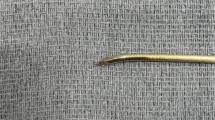Abstract
Background
Navigational techniques in orthopaedic trauma surgery have developed over the last years leaving the question of really improving quality of treatment. Especially in marginal surgical indications, their benefit has to be evident. The aim of this study was to compare reduction and screw position following 3D-navigated and conventional percutaneous screw fixation of acetabular fractures. The study hypothesis postulated that better fracture reduction and better screw position are obtained with 3D navigation.
Materials and methods
Preoperative and postoperative CT scans of 37 acetabular fractures treated by percutaneous screw fixation (24 3D-navigated, 13 conventional) were evaluated. Differences in pre- and postoperative fracture gaps and steps were compared in all reconstructions as well as the screw position relative to the joint and the fracture.
Results
The differences in fracture gaps and fracture steps with and without 3D navigation were not significantly different. Distance of the screw from the joint line, angle difference between screw and ideal angle relative to the fracture line, length of the possible corridor used and position of the screw thread did not show any significant differences.
Conclusion
Comparison of 3D-navigated and conventional percutaneous surgery of acetabular fractures on the basis of pre- and postoperative CTs revealed no significant differences in terms of fracture reduction and screw position.







Similar content being viewed by others
References
Briffa N, Pearce R, Hill AM, Bircher M (2011) Outcomes of acetabular fracture fixation with ten years’ follow-up. J Bone Joint Surg Br 93(2):229–236. https://doi.org/10.1302/0301-620x.93b2.24056(PubMed PMID: 21282764)
Gansslen A, Pohlemann T, Paul C, Lobenhoffer P, Tscherne H (1996) Epidemiology of pelvic ring injuries. Injury 27(Suppl 1):S-a13-20 (PubMed PMID: 8762338)
Ochs BG, Gonser C, Shiozawa T, Badke A, Weise K, Rolauffs B et al (2010) Computer-assisted periacetabular screw placement: Comparison of different fluoroscopy-based navigation procedures with conventional technique. Injury. 41(12):1297–1305. https://doi.org/10.1016/j.injury.2010.07.502(PubMed PMID: 20728881)
Borrelli J Jr, Goldfarb C, Ricci W, Wagner JM, Engsberg JR (2002) Functional outcome after isolated acetabular fractures. J Orthop Trauma 16(2):73–81 (PubMed PMID: 11818800)
Crowl AC, Kahler DM (2002) Closed reduction and percutaneous fixation of anterior column acetabular fractures. Comput Aid Surg 7(3):169–178. https://doi.org/10.1002/igs.10040(PubMed PMID: 12362377)
Oberst M, Hauschild O, Konstantinidis L, Suedkamp NP, Schmal H (2012) Effects of three-dimensional navigation on intraoperative management and early postoperative outcome after open reduction and internal fixation of displaced acetabular fractures. J Trauma Acute Care Surg 73(4):950–956. https://doi.org/10.1097/ta.0b013e318254308f(PubMed PMID: 22710769)
Matta JM (1996) Fractures of the acetabulum: accuracy of reduction and clinical results in patients managed operatively within three weeks after the injury. J Bone Joint Surg Am Vol 78(11):1632–1645 (PubMed PMID: 8934477)
Puchwein P, Enninghorst N, Sisak K, Ortner T, Schildhauer TA, Balogh ZJ et al (2012) Percutaneous fixation of acetabular fractures: computer-assisted determination of safe zones, angles and lengths for screw insertion. Arch Orthopaed Trauma Surg 132(6):805–811. https://doi.org/10.1007/s00402-012-1486-7(PubMed PMID: 22358222)
Stockle U, Schaser K, Konig B (2007) Image guidance in pelvic and acetabular surgery–expectations, success and limitations. Injury. 38(4):450–462. https://doi.org/10.1016/j.injury.2007.01.024(PubMed PMID: 17403522)
Gras F, Marintschev I, Klos K, Muckley T, Hofmann GO, Kahler DM (2012) Screw placement for acetabular fractures: which navigation modality (2-dimensional vs. 3-dimensional) should be used? An experimental study. J Orthopaed Trauma 26(8):466–473. https://doi.org/10.1097/bot.0b013e318234d443(PubMed PMID: 22357092)
Mosheiff R, Khoury A, Weil Y, Liebergall M (2004) First generation computerized fluoroscopic navigation in percutaneous pelvic surgery. J Orthop Trauma 18(2):106–111 (PubMed PMID: 14743031)
Xu P, Wang H, Liu ZY, Mu WD, Xu SH, Wang LB et al (2013) An evaluation of three-dimensional image-guided technologies in percutaneous pelvic and acetabular lag screw placement. J Surg Res 185(1):338–346. https://doi.org/10.1016/j.jss.2013.05.074(PubMed PMID: 23830362)
Schwabe P, Altintas B, Schaser KD, Druschel C, Kleber C, Haas NP et al (2014) 3D-fluoroscopy navigated percutaneous screw fixation of acetabular fractures. J Orthopaed Trauma. https://doi.org/10.1097/bot.0000000000000091(PubMed PMID: 24662989)
Magu NK, Gogna P, Singh A, Singla R, Rohilla R, Batra A et al (2014) Long term results after surgical management of posterior wall acetabular fractures. J Orthopaed Traumatol 15(3):173–179. https://doi.org/10.1007/s10195-014-0297-8(PubMed PMID: 24879360; PubMed Central PMCID: PMCPmc4182623)
Berger-Groch J, Lueers M, Rueger JM et al (2020) Accuracy of navigated and conventional iliosacral screw placement in B- and C-type pelvic ring fractures. Eur J Trauma Emerg Surg 46(1):107–113
Funding
No external funding was received.
Author information
Authors and Affiliations
Corresponding author
Ethics declarations
Conflict of interest
The authors declare that they have no competing interest.
Additional information
Publisher's Note
Springer Nature remains neutral with regard to jurisdictional claims in published maps and institutional affiliations.
Rights and permissions
About this article
Cite this article
Swartman, B., Pelzer, J., Beisemann, N. et al. Fracture reduction and screw position after 3D-navigated and conventional fluoroscopy-assisted percutaneous management of acetabular fractures: a retrospective comparative study. Arch Orthop Trauma Surg 141, 593–602 (2021). https://doi.org/10.1007/s00402-020-03502-7
Received:
Accepted:
Published:
Issue Date:
DOI: https://doi.org/10.1007/s00402-020-03502-7




